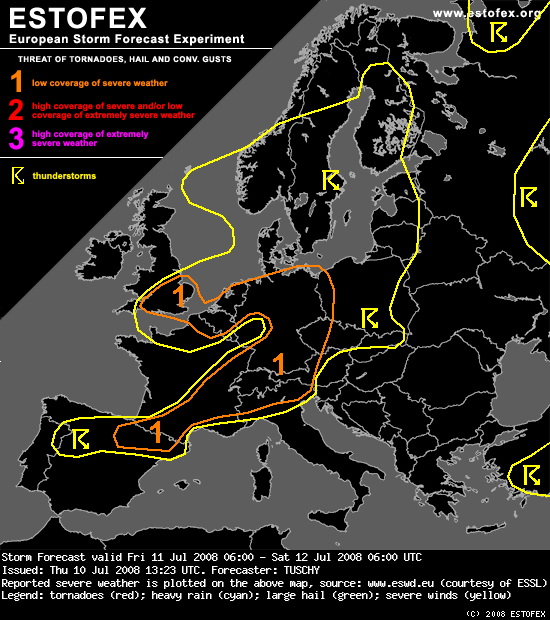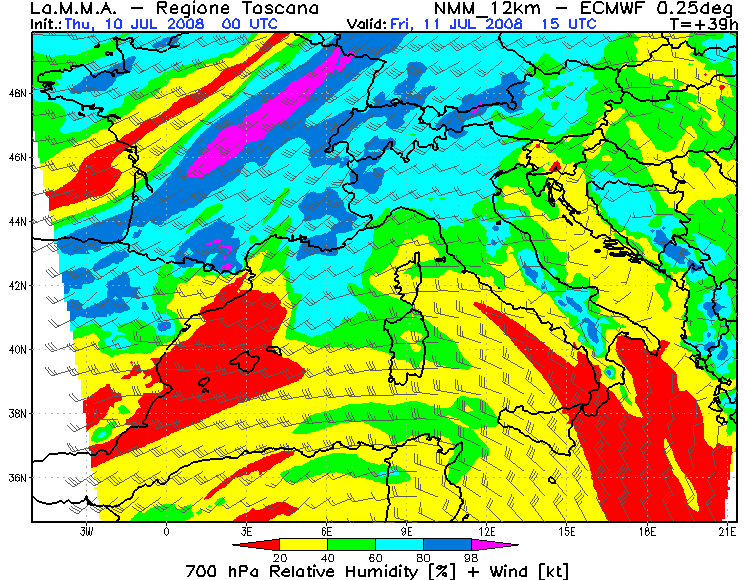Brandheiss und topaktuell - soeben erschienen:

DISCUSSION
... Germany, Belgium and the Netherlands ...
Despite high confidence in widespread nature of thunderstorm coverage, degree of organisation and kind of storm mode are somewhat diffuse. The main issue is a weakly positive tilted upper trough approaching from the west resulting in a sharp temperature gradient at all levels on its downstream side. A distinct focus for initiation is quite difficult to determine as various small disturbances are embedded in this strong SW - erly flow. A mixture of a slowly eastward propagating surface cold front, aforementioned disturbances and the trough axis itself should support scattered to widespread initiation, assisted by a overall weakly capped environment.
The thermodynamics are favorable for intense updraft evolutions in a swath, running from SW Germany to NE Germany, as a moist BL and steep mid - level lapse rates overlap. Instability values decrease markedly over NW Germany, Belgium and the Netherlands... at least until the evening hours as mid - / upper cold pool slides in from the west.
DLS is quite strong with 15 - 20m/s over SW / E and NE Germany, increasing significantly to more than 30 m/s over NW Germany. The decline of the speed maxima at different levels is very strong with 25m/s 700 hPa speed max over central Germany and a 40 m/s 500 hPa speed max over NW Germany all during the afternoon hours. At lower levels ( e.g. 850 hPa ), a broad 10 - 15 m/s jet overspreads the area with no real speed maximum in evidence. As those small disturbances rotate northeastwards, veering becomes locally more distinct with numerous SRH maxima, changing from run to run.
To combine all those jigsaw pieces comes along with an augmented degree of uncertainty. Final placement of the surface cold front also depends on how active the front was the night before, but at the moment we think that a swath along this slowly east / northeastward moving cold front will see the most concentrated area of severe weather, running from SW - Germany to E / NE Germany. Near parallel alignement to the background flow and weak capping should support early and scattered initiation with rapid clustering. Mainly during the early stage, when storms stay more discrete, there will be a distinct large hail and strong to severe wind gust threat, but betimes, storms will grow upscale into a few clusters. The highest large hail risk should be confined to S and E - Germany, changing to a wind threat over NE - Germany as 700 hPa speed max approaches. The only consistent signal during the past few model runs was an increase in thunderstorm coverage during the evening hours over SW Germany due to the approaching trough axis and we think that a cluster of storms will develop, moving northeastwards, although we would not be surprised to see an eastward shift of its track during the next few model runs . Low LCLs and locally enhanced LL shear along the front could also support an isolated tornado report although the risk should switch over to a local flash flood risk especially as storms cluster.
Less instability and warm ELs make the severe risk over NW Germany and the Netherlands during the late morning and midday hours more conditional. Latest model outputs of GFS had a more favorable environment from run to run with stronger instability release. We expanded the level area well to the NW as each updraft, penetrating deeper in the atmosphere cashes in on intense shear, resulting in an isolated large hail, strong to severe wind gust ( especially if storms bow out ) and isolated tornado threat.
Finally the risk of thunderstorm increases again during the late afternoon and evening hours over NW Germany, Belgium, the Netherlands and extreme NE France as mid - levels finally cool down and the upper trough axis approaches from the west. Deep convection is possible and as DLS remains strong and LL shear increases during the evening hours the risk of an isolated tornado / large hail report over those areas will be present.
... SE / S - France and Switzerland ...
MLCAPE values between 500 and more than 1000 J/kg will be present as DLS increases from the west to about 20 m/s. As surface front creeps in from the WNW, thunderstorms will go on / re - develop already during the morning hours. Shear and instability will be fine for large hail and strong to severe wind gusts, especially if more discrete storms can evolve ahead of this front. In addition, complex topography and already enhanced LL shear could result in a tornado report. Betimes, storms will grow upscale into a large storm cluster with an excessive rain risk.
... N - Italy and most parts of Austria ...
Moderately sheared atmosphere and about 1000 J/kg will be present and widespread thunderstorms will evolve as the lifting mechanisms approach from the west. A few large hail reports can be expected and hence the level - 1 area was expanded well towards the east.
... SE - UK ...
A strong convergence zone is forecast to cross the area during the peak heating hours from the NW. Airmass will be quite unstable with MLCAPE values of up to 500 J/kg ahead of this zone. GFS has signals of a strong amount of LL CAPE release as diabatic heating and CAA at mid - levels overlap. LCLs stay low and hence we issued a level - 1 for numerous funnel and tornado reports which could evolve along this SE - ward moving convergence zone.
Interessant beim fetten Teil ist der Teil mit Tornadoreports in Bezug auf die Topografie. Wir werden's sehen.


